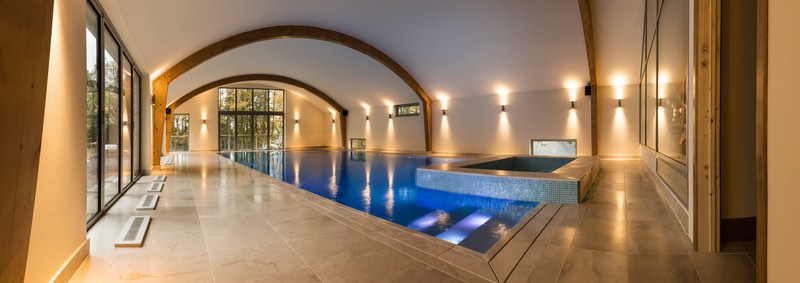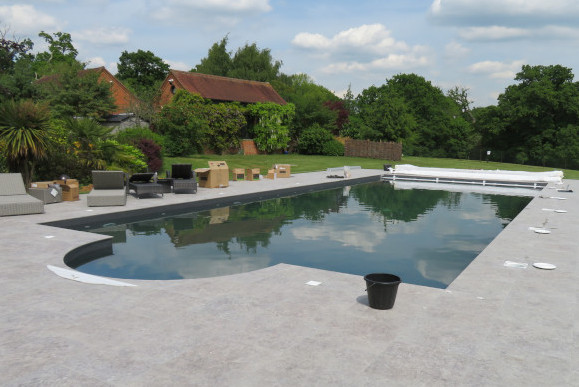Swimming Pool Design
I. Indoor or Outdoor
You do not need the advice of a pool architect or designer to decide where an indoor pool could be built. It will obviously depend on the size and shape of your house and garden.
- In an Extension - normally this will only be possible in a detached house with a large garden
- In a Separate Building - this may also be feasible in a semi-detached house or large terrace house
- In a Basement or underground in the garden - Underground pools can be surprisingly economic to build but basement pools are very costly even in a new-build.
The actual location of an Outdoor pool is always important and should always dominate the design process, whereas in indoor swimming pool design there are many other important factors to consider.
Indoor Swimming Pool Design Considerations:

Pros:
- Year-round use: Essential if the pool is for fitness training
- Control of Environment: Ideal temperature and humidity is maintained
- Water quality control: Automation is not expensive and very reliable.
- Has Potential for additional features: Combine with a gym, spa, or relaxation area
Cons:
- Higher construction costs: Requires building a dedicated space
- Ongoing maintenance: Requires ventilation and humidity control systems
- Potential for feeling enclosed: Can be less spacious than an outdoor pool
- Never provides the real joy of swimming in an outdoor pool in the summer
Outdoor Swimming Pool Design Considerations:

Pros:
- Lower initial cost: Typically, less expensive to build
- Open-air experience: Enjoy the natural surroundings and sunlight
- Can be much larger: Ideal for length swimmers
- Potential for entertaining: Creates an oasis for gatherings
Cons:
- Limited swimming season: Enjoyment depends on weather conditions
- Increased maintenance: Dealing with debris like leaves and insects
- Safety concerns: Potential hazards for children and pets
II. How Bluepools deals with Key Design Issues
We always provide clients with a Proposal describing in detail how we will assist and advise you throughout the design and installation of your pool project.
Without a doubt, the Concept Design we provide will ensure that each client fully benefits from the depth of our experience and engineering expertise in swimming pool design.
In contrast, pool installation contractors or pool architects never provide unique designs tailored to suit the precise circumstances of the site as they use highly standardised methods for every project and never employ experienced pool design engineers.
The Bluepools process is set up to achieve the following objectives:
- To provide entirely impartial advice on the pros and cons of the very wide variety of pool equipment currently available.
- To enable client's to fully benefit from 20+ years of Swimming Pool Design & Installation expertise as well as 45+ years of Civil & Structural Engineering experience.
- To identify all practicable options for the swimming pool project in the available area of land whilst bearing in mind the client's financial resources and site constraints.
- To provide accurate costings of the project at minimum initial cost to clients so that a decision can be made early in the project process.
Bluepools will visit the site before commencing any design work to:
- Identify any constraints such as existing structures, site level changes, ground water levels and the location of utility services or trees that must be retained.
- Identify and fully understand your objectives.
- Describe the available options with respect to tiling, liner, pool depths, deck level walls, covers and heating and note your feedback.
- Agree on the scope of the Concept Design.
We will then provide a Concept Design based on the site conditions, opportunities and constraints. The design would be undertaken by our highly experienced Design Team using State of the Art 3D software and incorporating all the latest and best swimming pool technology.
The Concept Design will be presented in a Folio with Isometric views, plans, sectional plans and sections that illustrate all relevant design features.
The Concept Design is the core product we provide as it incorporates the following:
- The knowledge gained from 20+ years experience of swimming pool design and construction.
- The professional expertise gained from 45+ years working as a fully qualified civil and structural engineer.
- State of the art knowledge of every piece of pool equipment that is currently available in the UK.
- The use of full 3D design software that ensures buildability and provides the isometric views clients find so useful in envisaging the project details and which are often needed for a planning application.
The Concept Design Folio will then be emailed to the client and amended as required on an iterative basis until final approval.
Following the Concept Design approval, Bluepools will provide a Quotation for the Detailed Design of the pool and all the Pool Equipment including the structural work. The Quotation will be broken down to show the individual prices for each type of equipment and the design fees.
We will also provide an estimate for the cost of builders materials, construction plant hire and labour costs.
The Client then has a highly realistic estimate of how much the pool is going to cost and can then decide whether to proceed. The Folio of drawings can also be used as the basis for the planning application if required.
Once approved, we will provide the detailed layout and structural design in a Folio of drawings for construction including structural design calculations and steel reinforcement schedules, pool plant, pipework schematics and electrical schematics.
Clients can nominate their own builder for the execution of the building works or Bluepools will assist in procuring quotations from local builders for the construction work, the PVC pipework and the electrical installation.
Clients can then appoint the nominated firms to undertake the building works and the PVC pipework and electrical installation. All pipework and electrical installation work must be installed and tested by qualified plumbers and electricians with the appropriate certification.
In either case, it is an essential condition of this offer that an experienced builder is appointed to act as the Site Manager that Bluepools can liaise directly with throughout the Construction Period. The Site Manager does not need to have any experience of pool construction but must have at least 10 years experience of supervising the construction of residential property.
- We provide impartial advice on the advantages and disadvantages of each product from the point of view of cost, efficiency and expected life.
- We supply an Operations Manual with detailed instructions on how to operate every aspect of the pool. This includes drawings and details of all the equipment and the manufacturers warranties so that clients can always go back to the manufacturer.
- We check that everything has been installed properly and then commission the equipment.
- There is a simple division of responsibility - the Builder is responsible for all the building and installation work and Bluepools is responsible for the Specification, Capacity and Fitness for Purpose of the Pool Equipment.
- Finally, and most importantly, the total cost will be at least 40% less than a professional pool builder would charge and the pool will be of far superior quality.
The Pool Equipment is provided with a one year Manufacturer Guarantee from date of delivery with a replacement provided if proved to be defective as a result of a manufacturing defect.
Bluepools Ltd. guarantees to replace, free of charge, any item of Pool Equipment that does not meet the current domestic pool water quality standards in the swimming pool industry and any particular requirement specified by the client during the Concept Design Stage.
